|
THE TOP OF THE CONTINENT
|
IX
A LONG LIFE AND A HAPPY ONE
SOME OF THE TREES IN THE SEQUOIA NATIONAL PARK WERE GROWING THERE WHEN PHARAOH MADE CAPTIVE THE CHILDREN OF ISRAEL
NOW there arose up a new king over Egypt which knew not Joseph. And he said unto his people, Behold, the people of the children of Israel are more and mightier than we: Come on, let us deal wisely with them; lest they multiply and it come to pass that, when there falleth out any war, they join also with our enemies and fight against us, and so get them up out of the land.
Therefore they did set over them taskmasters to afflict them with their burdens. . . . And they made their lives bitter with hard bondage, in mortar and in brick, and all manner of service in the field; all their service, wherein they made them serve, was with rigor.
While Pharaoh was afflicting the children of Israel, as related in the first chapter of Exodus, upon the opposite side of the world a seed so small that one must have looked closely to recognize it as a seed, sank into the warm soil of a gentle valley beneath the saw-toothed snowy mountains of what is now called California, and, in due time, thrust forth a slender green stalk. This stalk grew rapidly, for the soil was rich, the air soft, and the sheltering forest warm and shady. The first summer it grew a foot or more, straight as an arrow, and put forth small branches and several plumes of feathery, pine-like leaves that seemed unduly large for so small a stalk. In winter it was buried under many feet of snow, and protected from the frost and ice.
The second summer it sprang strongly upward, so that its sharp-pointed top brushed the belly of the deer bounding over it to escape the wolves.
Its tenth summer discovered it a vigorous young tree with sturdy branches. Its foliage now was thick and brilliantly green, each large hanging plume heavy with carved waving filaments. It was a thing of beauty. A cousin to the firs and pines, its neighbors, it far surpassed those of its own age in charm of outline and in softness of foliage and color. It surpassed the pines in height, also; it looked over their heads to its own brothers here and there discernible among the red and gray stems of the old forest.
Many snows fell and melted, many summers came and went, and the strong and ambitious young sequoia forged its pointed shaft aloft. While it was still an infant it overtopped the lodge-poles. Still a sturdy child, it overmatched the adult oaks. Its trunk was spindling but erect, the figure of aspiring youth.
A thousand years after Pharaoh had led the Jews captive into Egypt, Nebuchadnezzar, King of Babylon, besieged Jehoiachin, the young King of Judah, in his splendid city of Jerusalem.
And he carried out thence (II Kings 24 :13) all the treasures of the house of the Lord, and the treasures of the King's house, and cut to pieces all the vessels of gold which Solomon, King of Israel, had made in the temple of the Lord, as the Lord had said. And he carried away all Jerusalem and all the princes and all the mighty men of valor, over ten thousand captives, and all the craftsmen and smiths. . . . And he carried away Jehoiachin to Babylon, and the King's mother and the King's wives and his officers, and the mighty of the land; those carried he in captivity from Jerusalem to Babylon.
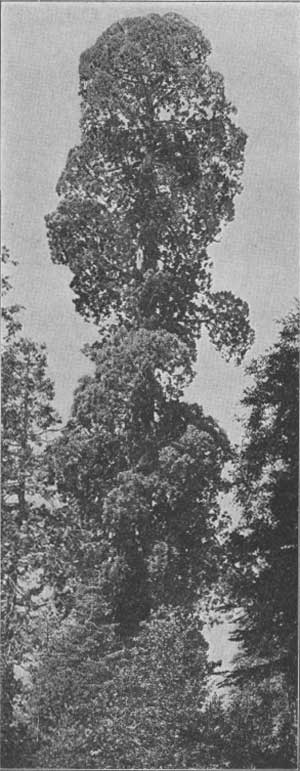
|
| Sequoia-tree about 1,500 years old. Observe its rounded top and closely folded mantle of foliage |
While Nebuchadnezzar in his turn was wrecking vengeance upon the unhappy children of Israel, the sequoia of the warm valley beneath the saw-toothed snowy mountains was developing its splendid youth. It had outlived many generations of lesser trees. Forests of sugar-pine, Douglas fir, yellow pine, maple, birch, and oak had arisen, attained maturity, and passed back into the earth that bore them. They had been succeeded by new forests, ever renewing themselves, ever struggling into view of the cloudless summer sky, ever crumbling into decay.
And still the sequoia, glorious in its own bounding life, forged upward. Its lowest branches were even with the tops of many trees now decades past maturity. But the sequoia was still young. Youth was written in its noble aspect, in its proud carriage, in the rigid power of its bent limbs, in the vividness of its tawny green. But now the plumes that had numbered thousands in the days of Pharaoh, numbered hundreds of thousands. And the pointed top which then bored so swiftly upward had grown broad and rounded. It was a crown, for the Prince had become a King.
Now the sequoia towered even with the tallest and noblest of its majestic cousins, the sugar-pines. But it had outlived many generations of sugar-pines. Those which now rivalled it were of younger, swifter growth; but even they had reached the height of tide; soon they, too, would drop under the winter gales.
Six centuries passed and Christ was born in Bethlehem. Israel had found her unconquerable King, and mankind had found its Saviour.
And on that first Christmas Day the sequoia of the valley beneath the saw-toothed snowy mountains, King of Trees, lifted its calm head far above the forest's highest top. It was the first to greet the rising sun that Christmas morning, the last to watch its setting glory. Nobly it lifted its thickening red trunk above the snows, and spread its glistening evergreen to the crisp air.
The sequoia now had attained its greatest height. It towered above all others. Its stem had broadened at the base, and rose thick and straight, tapering slightly to its crown. A hundred feet above the ground its diameter was greater than the base of the giant pines around it. Two hundred feet up its diameter was greater than the base of any except the very largest pines. It rose like a cathedral column.
Many feet above the ground, it thrust out at right angles its lowest branches, thicker than the trunks of most forest-trees, the elbows sharply bent. For the sequoia did not spread its robes; it wrapped its foliage about it, as a Roman wrapped his toga. Its leafy outline was erect and slender, as perpendicular as its mighty trunk; a broad column supporting, under the sky, its dome of living green. The King of Trees, indeed!
Other centuries passed. The Roman Empire rose to its fall. Barbarous hordes warred over the division of Europe. Swaying boundaries settled. Civilization followed Christianity. Art followed civilization. Literature followed art. Commerce discovered the world. Freedom was born. The Americas were developed. Science transformed living.
And during the nineteen hundred years from Christ's birth until to-day, years of turmoil and infinite striving, the sequoia in the valley beneath the Sierra Nevada Mountains has grown into its splendid maturity. Look at it to-day before you. Note its magnificent bulk. Note its aged, knotted limbs, its thinning crown of foliage, its masterful air of the fulness of life. Look well at it, standing there in fullest majesty, thick limbed, powerful, keenly alive to the uttermost tip of its farthest plume, sternly beautiful, manifestly King, the biggest and oldest and the most lordly living thing.
"Doctor McKinley," demanded Margaret, "do you mean to say you are talking about this very tree here right in front of us?"
"I do," said Doctor McKinley, "I have been telling you the history of the General Sherman Tree—right here in front of us."
"Goodness!" said Margaret, "I thought it was just a story. And so you mean to say—Oh! I wish I had known! It would have been so much more real."
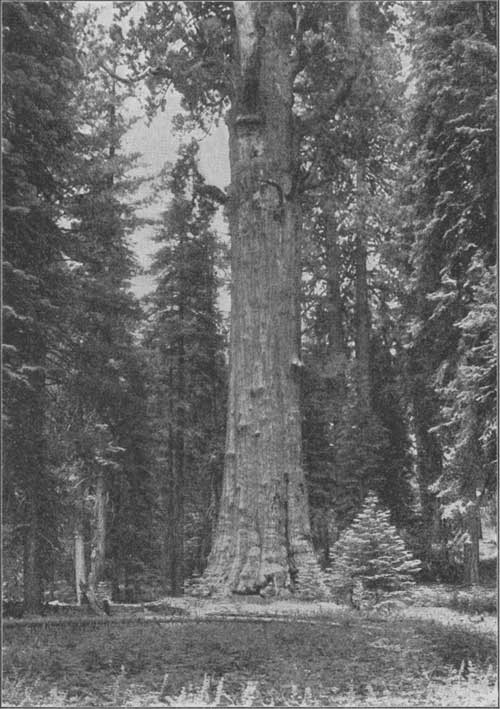
|
|
General Sherman Tree, from south side Photograph by Lindley Eddy |
"Yes, I do mean to say that this tree that you have just been dancing around probably began growing when Pharaoh took the children of Israel into captivity, and has been growing right here during all the history of the world since. Do you wonder that it has become thirty-six and a half feet in diameter? There have been bigger sequoias even than this. John Muir actually counted the rings of a fallen giant that must have begun to grow while the Tower of Babel was building—that is, in the eleventh chapter of Genesis. That tree had more than four thousand rings. Of course the age of the General Sherman Tree can only be estimated, as it is still standing. One must count the rings to make sure. But it is about thirty-six hundred years old. There is a fallen tree a few miles back in the forest that may have been as large as this. We'll visit it to-morrow, and walk through its trunk."
"There must be a lot of timber in this tree," said practical Jack.
"Sawed into inch boards, this tree would make a box large enough to hold the greatest steamship ever built. Yes, and put a lid on the box. It will help you to realize the thickness of this trunk to know that a hole could be made in it large enough to drive a wagon and two street-cars through it, side by side, and still leave the sides sufficiently strong to support the tree."
"Oh," said Margaret, gazing up at it, "if I could only make the girls at home understand how truly, awfully big it is."
"Let me give you a recipe," said Doctor McKinley.
"When you go home take the girls to a church, or other large building, with an empty space or park adjoining. Get Jack to measure out against the front of the church a distance equal to the diameter of the General Sherman Tree, thirty-six feet, six inches, and drive in stakes big enough to see plainly at a distance.
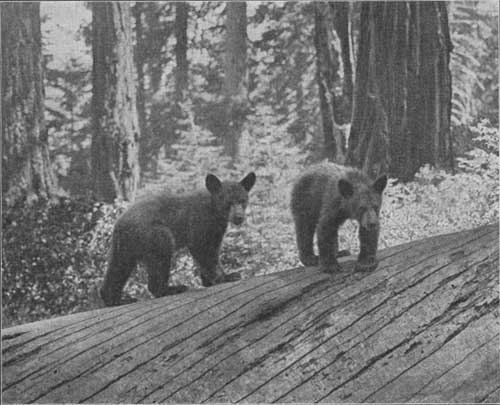
|
|
Bear cubs are numerous and friendly Photograph by Lindley Eddy |
"Then measure back on the ground in front of the church a distance equal to the height of the tree, two hundred and eighty feet, and stand there facing the church. Then look hard at the stakes and imagine the trunk of the tree filling the space between them. Then raise your eyes slowly and imagine this broad trunk rising up against the sides of the church and above it. When you are looking upward at an angle of forty-five degrees you will be looking at the spot in the sky where the top of the tree would be if it were growing in front of the church."
"Gee!" said Jack. "What fun! But how will you know when you are looking up at an angle of forty five degrees?"
"That is quite easy," said Doctor McKinley. "Get a large piece of stiff cardboard, and cut it exactly square. Then draw a line from its opposite corners and cut the card along this line. That will give you two right-angled triangles. Hold one of these in front of your face so that the shorter base will exactly parallel the ground; tack it to a tree or pole so that you may be sure about it. Then with your eye at the lower corner, glance up the slanting side, and you will have your angle of forty-five degrees. Where the point in the sky which you then see intersects the imaginary line of the trunk rising above the church, you will have the height of the General Sherman Tree if it grew in front of your church."
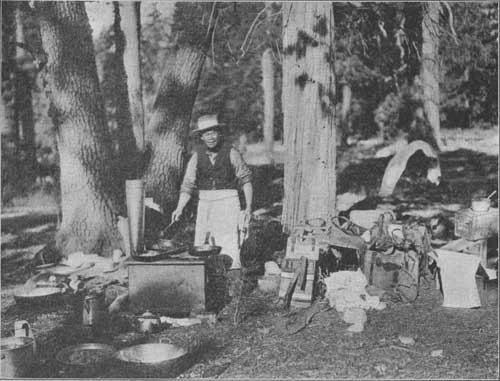
|
|
A wonderful place to camp out Photograph by Edward S. Curtis |
"Oh, how splendid!" said Margaret, jumping up and down in great excitement. "We'll do it the minute we get home."
"But do you understand just how to do it?" asked Doctor McKinley.
"No," said Margaret, "but what do I care? Jack does. Don't you, Jack?"
Jack went over the plan carefully with Doctor McKinley, and made notes and diagrams. Then he nodded confidently to Margaret.
"All right, kid," he said, "I've got it. We'll get the girls and do it the minute we get home. I know just the place."
This was their first afternoon in the Sequoia National Park. They had come in by automobile stage from the railroad-station in the valley, and had settled at the camp in the Giant Forest. They had found Doctor McKinley awaiting them. Their first move, naturally, had been to visit the General Sherman Tree; they spent the afternoon there.
"Why are all those sticks hanging to the bark?" asked Margaret.
Uncle Billy investigated. He threw bits of wood at them, and finally succeeded in dislodging one, which he examined carefully.
"It has been pointed with a knife," he said, "and has somebody's name written on the side of it."
Doctor McKinley laughed.
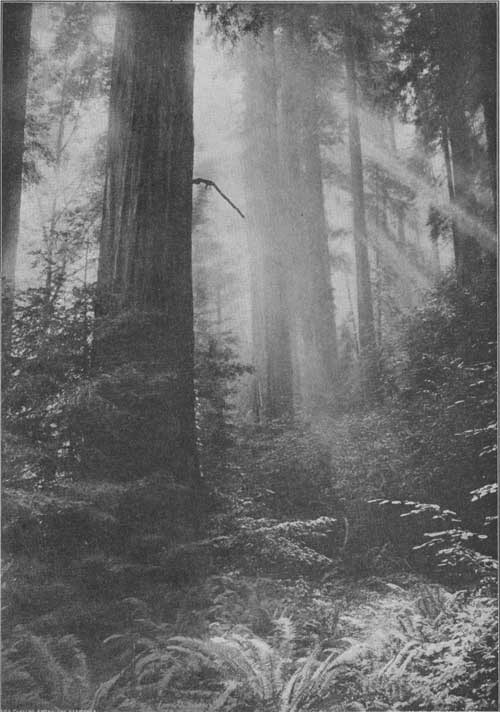
|
| Sunrise in the Giant Forest |
"Those people who have the craze for carving or writing their names everywhere," he said, "are stopped here by the rules. Government imposes fines upon those who deface the big trees. So that is the way they get around the rules. It is harmless enough. It does not hurt the spongy bark to shoot a sharpened stick into it. The bark is a foot and a half thick."
"I'm going to do it, too," cried Margaret.
But Jack was already sharpening a stick, and after many tries he succeeded in so throwing it that the pointed end penetrated and held the bark ten feet or more above their heads.
"It is only polite," Margaret said, "to leave our cards when calling. General Sherman won't forget us, now."
The next morning's walk through the tangled Giant Forest was an experience full of pleasure. The extreme luxuriance of growth astonished them. Gigantic sugar-pines here reached their limit of two hundred feet, and the Douglas fir vied with them. Yellow pines, their bark figured like alligator travelling-bags, Margaret said, abounded; monsters sometimes even equalling the firs. The variety of cone-bearing trees was surprising. There were cedars of magnificent proportions. All the pines and firs were festooned with bright green moss, which hung in long plumes from their trunks and boughs. The sequoias alone carried no moss.
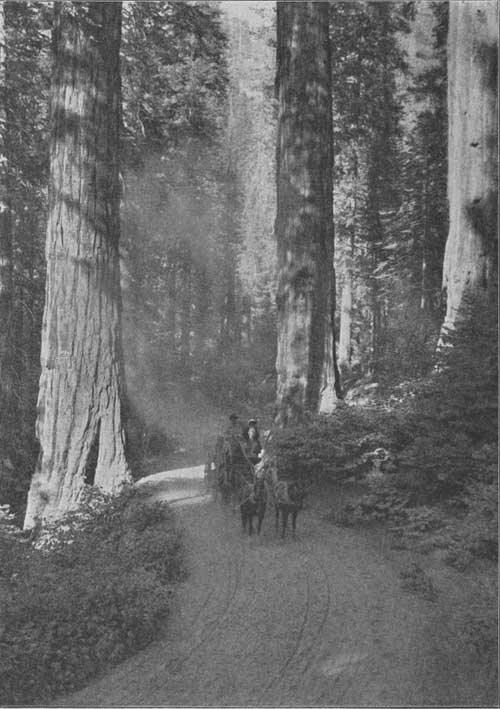
|
|
Sugar-pines in the Giant Forest Photograph by Lindley Eddy |
But in this forest of conifers were found also deciduous trees in large numbers. Live-oak abounded, and oaks of many other kinds. Maples, sweet-scented bay, birches of large girth with curling coppery paper bark, grew in thickets; while passage was often difficult through the luxuriant tangle of bushes of innumerable kinds and varied beauty. And here and there, sometimes alone, generally in groups scattered or closely bunched, rose the gigantic purplish-red columns of the sequoias. It was also a forest of wild flowers and a forest of birds.
The children shouted whenever they broke through a tangle to find before them one of the towering monsters. There were so many of them! They found the Abraham Lincoln Tree, whose diameter is thirty-one feet, and the William McKinley Tree, which, though of smaller girth, towers eleven feet higher than the General Sherman Tree. They greatly admired the perfection of the Theodore Roosevelt Tree, one of the very noblest in form and color in the Giant Forest. They wondered at the many groups whose trees stood close together like cathedral columns.
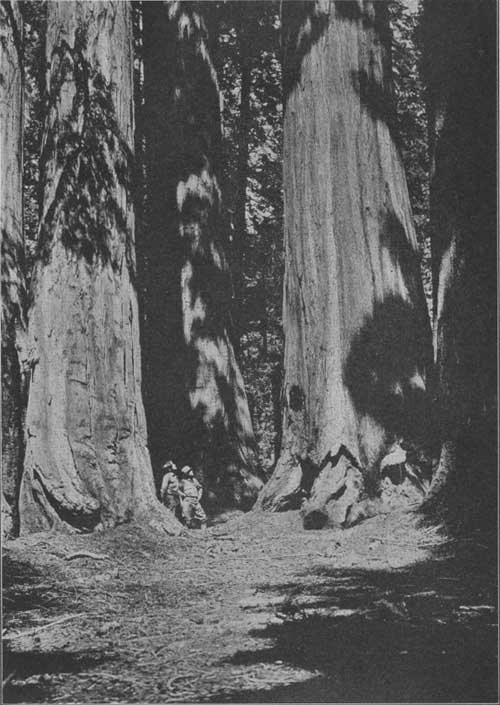
|
| Group of sequoias in the Giant Forest |
"How many sequoias are there?" asked Mrs. Jefferson.
"More than a million, big and little, in the Sequoia National Park," said Doctor McKinley. "Twelve thousand of them are more than ten feet in diameter. There are also a few in the Yosemite and elsewhere."
"I want to sleep out of doors and look up into one of these groves lighted by camp-fires," said Aunt Jane. "I want to wake in the morning with this noble roof overhead."
Aunt Jane's wish was granted before they left the Giant Forest, and it proved an experience that none of them forgot. It seldom rains in the Giant Forest during the summer, and sleeping out of doors was safe and easy.
After lunch they started for the fallen tree, but Doctor McKinley, who had promised to guide them, could not be found. So they secured another guide. Uncle Billy and Aunt Jane were missing, too. As they approached the tree, they overtook Doctor McKinley and Aunt Jane, who had started in advance, and were walking slowly.
"Where's Uncle Billy?" demanded Margaret.
"I think he said he was going fishing," said Aunt Jane innocently.
Margaret whispered to Jack.
"Didn't I tell you?" she asked. "Uncle Billy was as gay as a lark in the Yosemite, and here as soon as Doctor McKinley arrives, he gets glum and runs off by himself."
"I wouldn't run away if I was Uncle Billy," said Jack valiantly. "I'd fight him."
"Yes, you would," said Margaret scornfully. "The same way you fought the bear in the Yellowstone."
Jack changed the subject.
The fallen monster proved to be a crowning delight. It had been a tree of enormous size, but now was prostrate. The trunk was embedded in the rich soil. Its enormous roots were fully exposed, however, and through them the hollow trunk could be entered by a score or more of men and horses. In fact, a large party was there already with a motion-picture camera. The operator was turning the crank upon a party emerging from the great hole in the roots.
The temptation was too great for Jack. He broke away on the run, dashed into the hole, and marched out at the tail of the last horse, his head held high, his thumbs caught in the armholes of his waistcoat.
Margaret was scandalized.
"There!" she exclaimed. "That's the cheekiest and most impudent thing I ever saw a boy do. You've spoiled the man's picture."
Jack was well scolded by his mother, too, who fully agreed with Margaret, though she chose her phrases more carefully. Uncle Tom seconded her, and poor Jack was quite crestfallen.
Mrs. Jefferson apologized to the leader of the party, but he made light of it.
"It will be a neat touch," he said. "A bit of involuntary comic is a good thing sometimes. The boy was so immensely proud of himself that it will make the audience laugh. I'm glad he did it."
After the motion-picture people had gone Doctor McKinley led his party a hundred feet or more up the fallen trunk, and showed them a large hole through which a man and horse might enter.
"A few years ago," he said, "it was possible to ride your horse into this hole, pass through the trunk mounted, and come out through the hole in the root. The spring rains, however, have washed so much soil inside the trunk that it is impossible to get a horse through now. But it will be easy for us to enter afoot."
The interior was an apartment more than a hundred feet long, and from eight to fifteen feet wide. The floor was flat, beaten soil; the roof a wooden arch.
"It would be the splendidest place to live," said Margaret admiringly.
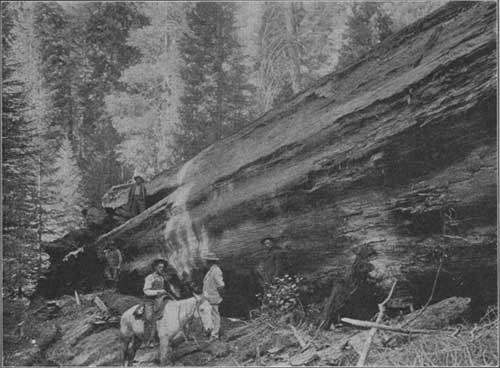
|
| A fallen monster |
"And that is no fancy," said Doctor McKinley. "Hollow trunks like these were shelters for Indians long before white men discovered the sequoias, and they frequently have served as wilderness homes for hunters and explorers and prospectors. John Muir often lived in them during the years he wandered alone through the Sierra Nevada Mountains studying the sequoia-trees; I have no doubt he has slept many peaceful nights in this very tree. By the way, Margaret, do you know why the Spaniards named the great mountains back of us the Sierra Nevada?"
Margaret shook her head.
"Sierra Nevada means the saw-toothed, snowy mountains because______"
"Oh!" she interrupted, "I see now. That's why you called them that in the story."
Jack was missing. They called him but without reply. They hurried out and shouted his name. Mrs. Jefferson, thinking of the tangled wilderness they had come through, was seriously alarmed. Aunt Jane was distracted; Uncle Tom was more vexed than worried; Margaret was scared and tearful. When it was evident that he was out of hearing of their shouts, they gathered by the great root to determine what to do. Doctor McKinley tried to be comforting; he said the park rangers surely would find him before nightfall, but Mrs. Jefferson was not comforted. At best, the nights were very cold in the big woods. They talked earnestly. Margaret began to sob aloud.
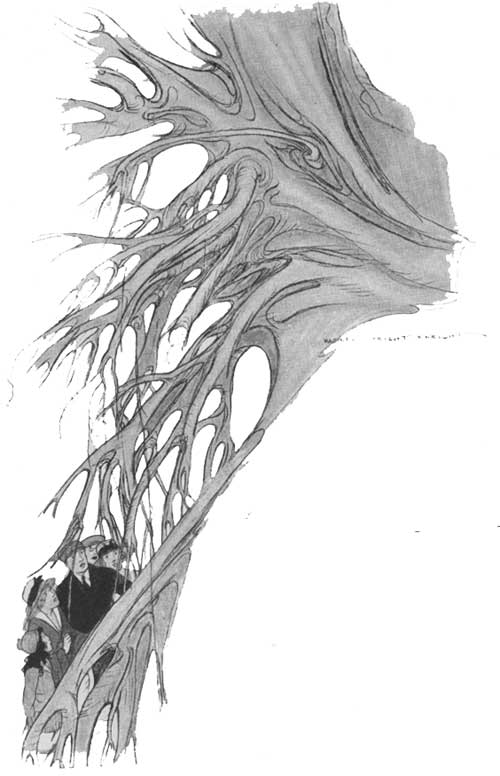
|
| Suddenly a loud, gleeful shout brought the conference to a startled finish |
Suddenly a loud, gleeful shout brought the conference to a startled finish. There sat Jack, grinning happily, upon the highest up-standing root of the tree, perhaps forty feet above their heads. But, as the Jeffersons looked up at him, his smile faded; it became instantly apparent to him that what had seemed so good a joke to him was no joke to them.
Mrs. Jefferson, indeed, turned quite pale, and called:
"Don't move, Jack! Stay right where you are and hold tight. Uncle Tom and Doctor McKinley will come up and get you. Oh, I wish we had a rope. Look out or you'll fall."
"I won't fall," cried Jack; "I'll climb down myself. I won't have any one come for me."
Uncle Tom already was rapidly climbing the tangled roots. Disregarding the protests from below, Jack hurriedly began to scramble down. It would be disgraceful to be helped. But his haste was his undoing. Full a dozen feet from the ground, he slipped and fell face downward.
Doctor McKinley, waiting below, caught him cleverly and lowered him safely to the ground. It is better right here to drop the curtain on the scene.
Later on Jack said to Margaret:
"Doctor McKinley is the only one that didn't jaw me. He's all right. I hope he gets her."
"Well, I don't," replied Margaret. "I'm for Uncle Billy, every time."
| <<< Previous | <<< Contents>>> | Next >>> |
yard2/chap9.htm
Last Updated: 30-Oct-2009